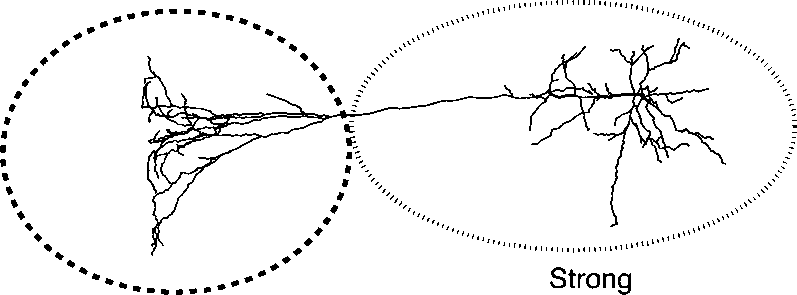112

Weak
Figure 4.2: Partitioning a realistic cell into strong and weak components. This cell is
p 18, a pyramidal cell from the cerebral cortex (Vetter et al., 2001). The strong component
encompasses dendrites that are close to the soma, where the active membrane properties
will have the largest effect, while the most distal tuft comprises the weak part, since there
the dendrites behave more like passive cables. The scale bar indicates 100 pm.
entries of the coupled “Hines” matrix resulting from the discretization of the transi-
tion condition will change because real neuronal morphologies will have non-uniform
branch radii. Once these changes are taken care of, writing the generalized RSW
model and discretizing it are straightforward.
For a general morphology, assume that we have placed the transition point xτ on
branch bτ- This naturally segments the morphology into two components, one strong
and one weak, as shown in Figure 4.2. The weak component consists of the segment
[0, xχ] of branch bτ and all branches that are its descendants. The strong component
is then the complement of this set, namely the segment [xτ, (⅛τ] °f branch bτ and
all branches which are not its descendants. Hence there are a total of Bs and Bw
branches in the strong and weak parts, respectively.
More intriguing information
1. A Theoretical Growth Model for Ireland2. Assessing Economic Complexity with Input-Output Based Measures
3. Consumer Networks and Firm Reputation: A First Experimental Investigation
4. Altruism with Social Roots: An Emerging Literature
5. Understanding the (relative) fall and rise of construction wages
6. The name is absent
7. he Effect of Phosphorylation on the Electron Capture Dissociation of Peptide Ions
8. The purpose of this paper is to report on the 2008 inaugural Equal Opportunities Conference held at the University of East Anglia, Norwich
9. The name is absent
10. DETERMINANTS OF FOOD AWAY FROM HOME AMONG AFRICAN-AMERICANS